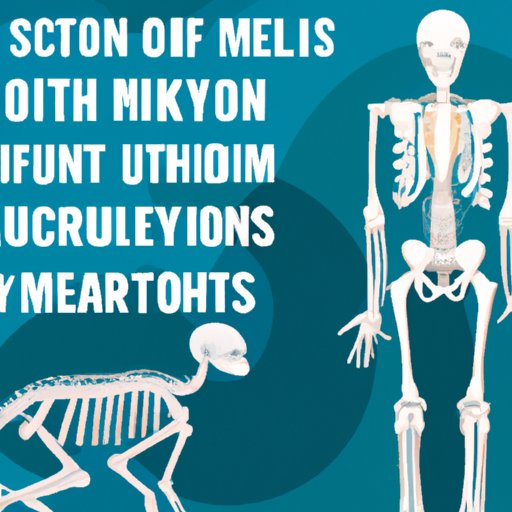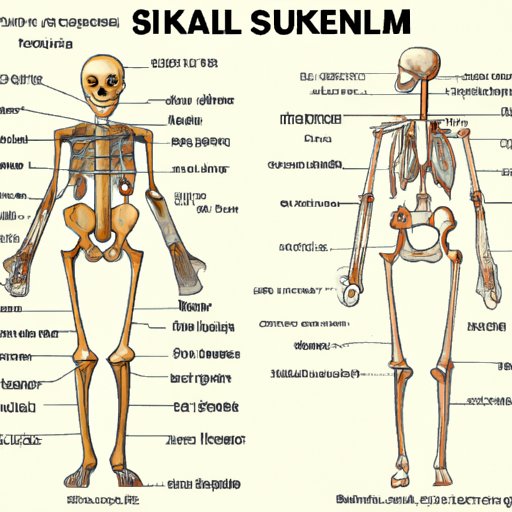Introduction
Have you ever wondered how many bones are in the human body? It’s a question that many of us have asked ourselves at some point, yet few of us know the answer. The human skeletal system is an incredibly complex and intricate structure, and it plays a critical role in supporting our bodies and allowing us to move and function. In this article, we’ll explore the human skeletal system in depth, discussing the number of bones in the body, their functions, and the importance of maintaining a healthy bone structure.
Why It Matters: The Importance of Knowing the Number of Bones in the Human Body
The number of bones in the human body is an essential piece of information for medical professionals, researchers, and scientists alike. Understanding the structure and function of the human skeletal system is critical for diagnosing and treating bone and joint disorders and injuries. For example, a broken bone or joint misalignment can cause significant discomfort or even impair a person’s ability to move, leading to a host of secondary health conditions.
Further, knowing the number of bones in the body can also benefit the general public. Educating people about their bodies can empower them to take an active role in their health and make informed decisions about their care. For example, a person who understands the role of calcium and other vital minerals in bone health is more likely to consume a balanced diet and take supplements as necessary.
According to the National Osteoporosis Foundation, about 54 million Americans suffer from or are at risk for osteoporosis, a disease that affects the bones and causes them to become brittle and weak. This figure highlights the importance of raising awareness about bone health and understanding the human skeletal structure.
Bones and Their Functions: A Guide to the Human Skeletal System
The human skeletal system comprises approximately 206 bones that work together to form our bodies’ framework and support our organs and tissues. Bones come in many shapes and sizes, but they all serve similar functions:
- Providing structure and support: The bones give your body its shape and are the framework around which your other organs and tissues are arranged.
- Protecting vital organs: Many bones, such as the skull and rib cage, protect internal organs from damage.
- Facilitating movement: Bones work in conjunction with muscles to allow you to move your body.
- Storing minerals: Bones store essential minerals such as calcium and phosphorus, which the body utilizes as needed.
- Producing blood cells: Some of the body’s blood cells are produced within the bone marrow.
Each bone in the human skeletal system can be classified into one of four categories:
- Long bones, such as the femur and the humerus, which are found in the arms and legs and are responsible for movement and support.
- Short bones, such as the bones in the wrist and ankle, which provide stability and support to the body.
- Flat bones, such as the sternum and the ribs, which protect internal organs and serve as points of attachment for muscles.
- Irregular bones, which have complex shapes and are found in the vertebrae and the facial bones.
All of these different types of bones work together in harmony to help you move, protect your organs, and maintain your body’s shape and structure.
How Humans Compare to Other Animals: Understanding Our Unique Bone Structure
Humans have a unique bone structure compared to other animals. Our bipedal nature and upright posture are some of the evolutionary factors that contributed to the number and arrangement of bones in our body.
While most mammals have over 300 bones, humans have only 206. This is because many of our bones have fused together over time to provide greater stability and support. For example, the four bones that make up your pelvis in other animals have fused together into one bone in humans.
Our bone structure is critical to our abilities and lifestyle. For example, the shape of our pelvis affords us the ability to walk upright, while our relatively large skulls allow us to accommodate our larger brains.
Maintaining a Healthy Bone Structure: Why Knowing About Human Body Bones Is So Essential
Maintaining a healthy bone structure is essential for overall health and wellbeing. One way to do this is by consuming a balanced diet rich in calcium, vitamin D, and magnesium, which are all essential for healthy bones. Additionally, regular exercise can help build and maintain bone density.
Education about the human skeletal system and bone health can help people identify signs of bone disorders, such as osteoporosis or arthritis, in their early stages. Early intervention can prevent further long-term damage and improve a person’s quality of life.
Neglecting bone health can have severe consequences, including increased risk for fractures, decreased mobility, and chronic pain.

Separating Fact from Fiction: Common Myths About the Human Skeletal System
Many misconceptions exist about the human skeletal system. Let’s debunk some of the most common myths:
Myth #1: Everyone has the same number of bones in their body. False – the number of bones can vary slightly from person to person.
Myth #2: Broken bones can regrow on their own. False – while bones can heal themselves, it is crucial to seek medical attention for more severe fractures and breaks.
Myth #3: Bones are dry and lifeless. False – bones are living structures that maintain a balance between the processes of bone formation and resorption.
By separating fact from fiction, we can better understand how our bodies work and how to keep them healthy.
The Study of Human Anatomy: How We Came to Know About Every Single Bone in Our Body
The study of human anatomy has a long and fascinating history, dating back at least as far as Ancient Greece. However, it wasn’t until the Renaissance and the Enlightenment that the field of anatomy began to flourish.
Advancements in technology, such as the discovery of the X-ray and MRI, have made it possible to study the human body in greater detail than ever before. Today, we have a thorough and detailed understanding of every single bone in the human body and the various systems they work with.
Quick Guide: Memorizing the Number of Bones in the Human Body
If you’re looking for an easy way to remember the number of bones in the human body, try this simple tip:
There are 206 bones in the human body. 2-0-6 rhymes with toes, so imagine yourself wiggling your toes, and you’ll have this number memorized in no time!
Conclusion
In conclusion, knowing the number of bones in the human body and understanding how they work is essential for overall health and wellbeing. By educating ourselves about bone health, we can make informed choices that help us maintain a healthy and active lifestyle. Understanding the human skeletal system can also help us appreciate the remarkable complexity of our bodies and the evolutionary factors that led to our unique bone structure.
